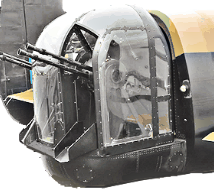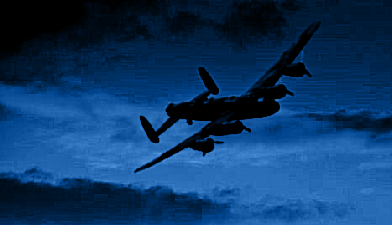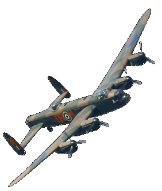





Royal Air Force pages
This is a Essay that is written by the late Donald Cooke a WWII Lancaster bomber tail gunner veteran. His grandson said to him one day "Granddad what's it like to fly in a Lancaster bomber?"
This essay is an articulate piece of writing it paints the picture of a flight in a Lancaster bomber, and no where is there a reference to why, what, or how about the war, it is extremely cleverly written for his grandson who he obviously loves dearly. Donald was one of the few Tail end Charlie's who survived the war, he has recently passed away, his son David came across this wonderful essay and has agreed that this can be published on yapps.co.uk for this we are very grateful that other people can read this very private moment of a granddad to his grandson, please enjoy:
My grandson wants to know what it is like flying in a Lancaster bomber. Well first of all It is different for every member of the crew as we are all in different parts of the plane doing our particular duties. The crew of a Lancaster consists of seven men. The pilot and engineer sit in the cockpit together up front, the pilot flying the plane and the engineer checking the instruments showing the engine revs and boost and calculating the fuel consumption. Their view in daylight is very restricted forward and then only upward. There are two small windows on each side but of course the pilot relies on his instruments rather than his vision. The bomb aimer lies full length right up in the nose of the aircraft, forward and below the pilot and engineer. He is surrounded by clear Perspex and has unrestricted vision all around. The navigator's position is in the fuselage on the port side (left), behind a bulk-head. He sits at a table with his maps and slide rule etc. and has one very small round window, but on operations, mostly at night, he has to draw a blackout curtain all around His "office" and work with a small light. The wireless operator is next, just behind the navigator, busy with his head phones, Morse key, radio etc. his "office" is similar to that of the navigator. Next, roughly two-thirds down from the front is the mid-upper turret with two machine guns which are mounted on top of the fuselage and the mid-upper gunner has a field of vision of 360? level and above but is restricted below by the fuselage. There is also a turret with two machine gins right at the very nose of the plane which are manned by the bomb aimer in an emergency. He also uses the turret when possible for a change rather than lying full length for hours on end. The last position is mine, the rear gunner or tail gunner as the turret is at the very end of the fuselage more like a platform surrounded by Perspex. It is equipped with four machine guns and because the rear gunner sits facing backwards all the Perspex in front of him has been removed for clearer vision.

When going on a flight the plane taxis from the dispersal point along the perimeter track to the runway. On operations there could be 25 or more aircraft going from your squadron so the planes have to queue up tight and keep moving until Aircraft Control gives permission to take off. Each plane takes off with less than one minute apart so that they don't get spread out too much. The navigator calls out the speed and the tail end lifts up first then as the navigator calls 120 m.p.h. the pilot lifts her off the runway and we are airborne. I think the first sensation is that of noise, four massive Merlin engines plus the sound of the slip stream from the propellers - making you glad you had a flying helmet on to cover your ears. Once we had gained some height we had various "in the air checks" - one being to check our intercoms to make sure we could all hear and be in touch with each other. I would count up to ten aloud whilst rotating the turret to the port side and then again rotating to starboard thereby ensuring that I was "in contact" in every position of the turret.
On exercises and training flights in daylight you really felt the pleasure of flying, seeing the clouds, fields with miles of stone walls, the railway lines and roads and being able to follow them with your eyes for miles and miles. One of the greatest pleasures I got when on a dull day we would break through the murky cloud into brilliant sunshine and the clouds then below us looked like a sea of pure white cotton wool. Sometimes the skipper [pilot] would lower the undercarriage and pretend to land on it and then settle the belly of the Lanc into it with startling results especially for me in the rear turret facing astern. The slipstream gouged a deep channel like a ravine, wider than the plane and perhaps sixty to seventy feet deep with very steep sides up which rushed the clouds, curling outwards at the top forming a kind of swirling parapet the full length, it was a wonderful site.
Operational flying which was mostly at night was very different, everyone concentrating on their jobs, my main duty was vigilance. I had to keep constant watch for enemy fighters and the danger of other Lancaster's crashing into us also the hazard over the target of planes dropping their bombs on to us. I also reported all sightings of nearby flack and searchlights.
After our bombing run we would turn onto the heading for home, diving first to gain speed and to clear the target area fast about 280 mph. One of the discomforts of flying in bombers was the severe cold especially at night when you were on a long trip of about eight or nine hours. To try to combat this we had special flying clothes. we wore a vest and long johns made of a mixture of pure wool and silk then our battledress uniform including a thick white polo-neck pullover, the next layer was a padded and quilted garment which covered the body arms and legs. The outside garment was called a Sidcot was similar in shape but made of much stronger material with pockets and a large fur collar plus a flying helmet including an oxygen mask and intercom, earphones and plug also heavy flying boots lined with lambs wool and last but not least four pairs of gloves, starting with a pair of silk then a pair of chamois leather and then woolly mittens with fingers and thumbs exposed and finally a pair of long leather gauntlets with zips. Although all these gloves were cumbersome it was dangerous to take them off as you risked getting frostbite and if you touched the guns with your bare hands they would stick to the metal because it was so very cold.

Later on, on operations we were issued with an electric suit, it was a one piece garment like the others with wires woven through it , it had small press studs at the ankles and cuffs which I could clip a pair of electric socks and gloves. It was very successful except once when the electric short circuited and burnt my sock and ankle. I spent the coldest three hours of my life, I believe it was about -48ºF and the skipper brought the plane lower in an attempt to reduce the cold. We had come across the North sea safely and headed for Lincoln and our airfield 57 squadron at East Kirby. You would think that we could of relaxed a little but since vigilance was a priority at all times and this was so for various reasons. many of our planes were arriving back, plus Lancs from 630 squadron who shared East Kirby with us [57 squadron], so there is a great risk of collision as none of the Lancaster's have any navigation lights on and we were completely blacked out.
The reason was that at this period in 1944 the enemy night fighters mixed in with the concentration of Lancs and followed us home, even joining in the circuit and coming in as though "to land" behind a Lanc and destroying it just before touchdown, flying down the runway shooting up another plane halfway down and having a go at any others that might be just turning off the runway or the perimeter track on its way to its dispersal point. To counteract this enemy tactic all planes were blacked out all the way home and the runways had no flares lit so we landed as follows: On approach to the airfield we would call up our traffic controller on the r. t. [radio telephone] giving our call sign of the day E.G. Cocktail to silksheen, G. George identifying our plane and
Silksheen the call sign of our airfield. We would then be given a number and the height at which to join the circuit all depending on the congestion around the circuit caused by Lancs arriving at various intervals. Everyone would try to be amongst the leaders arriving back so that we didn't have to queue too long in the mess to get our bacon and egg breakfast, which was a real luxury in those wartime days. The reason was that at this period in 1944 the enemy night fighters mixed in with the concentration of Lancs and followed us home, even joining in the circuit and coming in as though "to land" behind a Lanc and destroying it just before touchdown,
flying down the runway shooting up another plane halfway down and having a go at any others that might be just turning off the runway or the perimeter track on its way to its dispersal point. To counteract this enemy tactic all planes were blacked out all the way home and the runways had no flares lit so we landed as follows: On approach to the airfield we would call up our traffic controller on the r. t. [radio telephone] giving our call sign of the day E.G. Cocktail to silksheen, G. George identifying our plane and Silksheen the call sign of our airfield. We would then be given a number and the height at which to join the circuit all depending on the congestion around the circuit caused by Lancs arriving at various intervals. Everyone would try to be amongst the leaders arriving back so that we didn't have to queue too long in the mess to get our bacon and egg breakfast, which was a real luxury
in those wartime days. Eventually we would be called down to a lower height and await our turn. Remember all this in total darkness and extremely dangerous to enemy fighters whose speed was much faster, having to mix in with them all those bombers. When we got permission to land the skipper would fly around the circuit and at the correct position would call on the RT. "G
George flaps" he would then operate the flaps which would slow the plane down slightly and the controller would know exactly where we were. The next call up position the undercarriage was lowered and the skipper called "G George undercarriage" slowing the plane down further, only a few seconds later came the next call "G George funnel" and all the lights would be switched on, on each side of the runway and the lights forming the funnel to guide us into the flare path. We came in quickly, the pilot called "G George touchdown" and immediately all the lights went off. we carried on along the runway the next Lanc touching down before we reached the end. We then turned off the end of the runway and reported "G George clear". Then off to our dispersal to catch the truck to go for debriefing then our breakfast and bed.
“That Richard was 57 squadron and remember our motto "Corpus non Animum Muto"


Corpus non Animum Muto" translated is "The body weakens not the spirit".
© 2009 - 2022 David Cooke yapps.co.uk
| About us |
| Contact us |
| our policy |
| Viewing Notes |
| Acknowledgements |
| Yapp family |
| james Yapps Cockney history |
| William and Eliza |
| Hannah and Mathew |
| James William Yapp |
| Mathew and Alice |
| Aussie connection |
| Family not forgotten |
| Origination 1 |
| Origination 2 |
| Origination 3 |
| KSLI 1951 |
| KSLI journal |
| Journal pt.1 |
| Journal pt.2 |
| Bill Griffiths |
| LCpl Hanlon |
| Bob_West |
| KSLI Roll of Honour |
| News Clips |
| Military Career |
| George Yapp KIA Korea |
| George service pictures |
| Communications |
| Georges Letters 1 |
| Georges letters 2 |
| Last letters home |
| Georges Awards |
| UN Memorial Cemetery Korea |
| Georges Story |
| Exchange rates |
| World Time |
| Speed Tester |